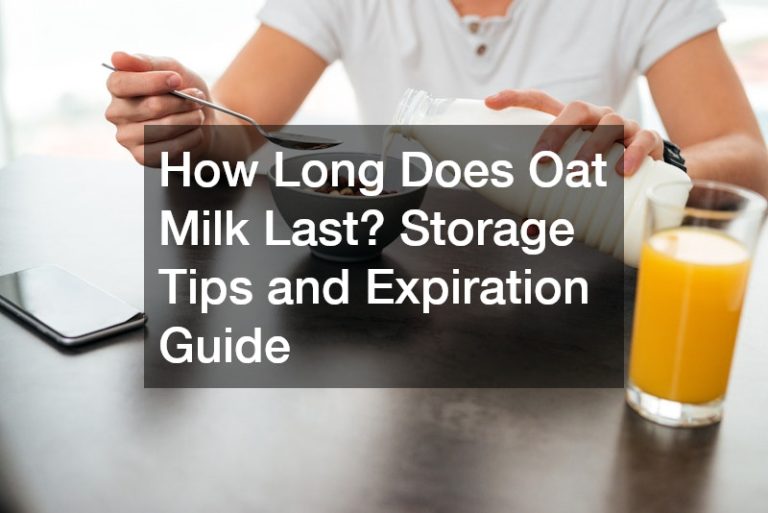How Can You Store Milk to Extend Its Shelf Life?
Milk is a daily staple for many households, but it has a relatively short shelf life, often spoiling faster than expected. Improper storage can lead to wasted milk and money, not to mention the inconvenience of running out of milk when you need it most. The good news is that you can significantly extend the shelf life of milk by following proper storage practices. In this comprehensive guide, we’ll explore how to store milk to maximize its freshness, reduce spoilage, and ensure it lasts well beyond the sell-by date.
Why Proper Milk Storage is Essential
Milk is a highly perishable product due to its rich nutrient content, which makes it an ideal environment for bacteria to thrive if not stored properly. Bacterial growth can cause milk to spoil, leading to unpleasant smells, taste, and potential health risks. Understanding why proper milk storage is important helps you take steps to extend its shelf life and reduce the risk of foodborne illnesses.
Proper milk storage not only ensures you get the most out of your purchase but also helps reduce food waste. By following some simple guidelines, milk can remain fresh for up to a week after its “sell-by” date, and even longer if frozen.
Ideal Temperature for Storing Milk
One of the most crucial factors in preserving the freshness of milk is keeping it at the correct temperature. Milk should always be stored in the refrigerator at a temperature of 32°F to 40°F (0°C to 4°C). Keeping milk at this temperature slows down the growth of bacteria and preserves its quality for a longer period.
Avoid Storing Milk in the Fridge Door
While many people store milk in the refrigerator door for easy access, this is not the best place to keep it. The temperature in the door fluctuates more frequently due to regular opening and closing, which can cause the milk to spoil more quickly. Instead, store milk in the coldest part of the refrigerator, typically towards the back, where the temperature remains most consistent.
Monitor Your Fridge Temperature
To ensure your milk stays fresh, it’s important to monitor the temperature of your refrigerator regularly. Use a fridge thermometer to make sure it stays within the optimal range of 32°F to 40°F. If the fridge temperature goes higher than 40°F, spoilage-causing bacteria can multiply quickly, reducing the milk’s shelf life.

Choosing the Right Container for Milk
Milk is typically sold in plastic or glass containers, and keeping it in its original packaging is usually the best option. However, if you need to transfer milk, either because you’ve bought it in bulk or you’re dividing it into smaller portions, the container you choose can impact how long your milk stays fresh.
Use Opaque, Airtight Containers
When transferring milk into a new container, make sure it is airtight and opaque. Light exposure can degrade the quality of milk by oxidizing the fats, which leads to a sour taste. Airtight containers reduce exposure to air, preventing spoilage and keeping milk fresh for longer.
Glass vs. Plastic Containers
If you decide to transfer milk, glass containers are generally better than plastic. Glass is non-porous and does not absorb odors or flavors from the fridge, which could otherwise affect the taste of milk. Additionally, glass can be cleaned more thoroughly and won’t break down over time, unlike plastic. However, plastic containers are convenient and shatterproof, making them suitable for freezing milk or transporting it.
Freezing Milk: Can You Do It?
Yes, you can freeze milk, and doing so can extend its shelf life by up to three months. Freezing is particularly useful if you buy milk in bulk or don’t use it quickly enough before it expires. Freezing allows you to keep milk fresh for a much longer time, but there are a few important things to keep in mind when freezing milk.
How to Freeze Milk Properly
- Leave room for expansion: Milk expands as it freezes, so be sure to leave about one inch of space at the top of the container to prevent it from bursting.
- Use an airtight container: If the original container is not freezer-safe, transfer the milk to a freezer-safe, airtight container to avoid freezer burn.
- Label the container: Always label the container with the date it was frozen so you know how long it has been stored.
Thawing Frozen Milk
When you’re ready to use frozen milk, the best way to thaw it is by placing it in the refrigerator for 24 to 48 hours. Avoid thawing milk at room temperature or in the microwave, as this can cause uneven thawing and spoilage. After thawing, the milk may appear separated, but a good shake will help restore its consistency. Keep in mind that thawed milk is best used for cooking or baking, as the texture may be slightly altered.
How to Handle Milk to Keep it Fresh
Proper handling of milk is just as important as storing it correctly. Every time you handle milk, there’s a risk of contaminating it, which can lead to quicker spoilage. Here are some tips to prevent milk from going bad due to poor handling practices.
Seal Milk Tightly After Each Use
Once you’ve opened the milk container, be sure to seal it tightly after each use. This minimizes exposure to air, which can cause milk to spoil faster. If air gets into the container, it can introduce bacteria, resulting in off-flavors and a shorter shelf life.
Avoid Cross-Contamination
Cross-contamination is one of the main reasons milk spoils before its time. Always use clean utensils when handling milk, and avoid drinking directly from the container to prevent bacteria from entering the milk. Make sure to wash your hands before handling milk or opening the container.
Don’t Leave Milk Out for Too Long
Milk should never be left out at room temperature for more than two hours. Leaving milk out, especially in warm environments, speeds up bacterial growth. If you accidentally leave milk out for an extended period, it’s better to be safe and throw it away rather than risk consuming spoiled milk.
Understanding Milk Expiration Dates
Milk containers usually feature a “sell by” or “use by” date, but understanding what these terms mean can help you decide if the milk is still safe to drink.
Sell By vs. Use By
- Sell By Date: This is the last date the milk can be sold by the retailer. Milk is generally still safe to consume for 5-7 days after this date, provided it has been stored properly.
- Use By Date: This is the date the manufacturer guarantees peak freshness. It’s best to use milk before this date, but it may still be good for a few days after, as long as it doesn’t smell or taste off.
Signs of Spoiled Milk
Even if the milk hasn’t reached its expiration date, it’s important to check it before using it. Signs that milk has spoiled include:
- Sour smell: Fresh milk has a mild, neutral smell, so a sour odor is a clear indication that it’s spoiled.
- Odd taste: If the milk tastes sour, bitter, or off in any way, it’s no longer safe to consume.
- Lumpy texture: Spoiled milk will curdle or form clumps.
Alternative Methods to Extend Milk’s Shelf Life
In addition to proper refrigeration and freezing, there are several other methods to help extend the shelf life of milk.
Vacuum-Sealing
Vacuum-sealing milk containers removes excess air and helps preserve its freshness. While this method requires specialized equipment, it can be particularly effective for extending the life of milk in the fridge.
Use Reusable Milk Storage Bags
Consider storing milk in reusable silicone storage bags. These bags are airtight, eco-friendly, and can be used for freezing or refrigeration. They take up less space and are perfect for dividing large quantities of milk into smaller portions.
UHT and Powdered Milk
If you need milk that lasts longer without refrigeration, consider using UHT (Ultra-High Temperature) milk or powdered milk. UHT milk is treated at higher temperatures to kill bacteria, making it shelf-stable for several months. Once opened, UHT milk needs to be refrigerated like regular milk. Powdered milk is another option, as it can be reconstituted with water and lasts significantly longer than fresh milk.
How About Oat Milk?
The expiration date depends on whether the oat milk is shelf-stable, refrigerated, or homemade. Shelf-stable oat milk can last up to 12 months unopened, but once opened, it must be consumed within 7 to 10 days. Refrigerated oat milk generally expires within 5 to 7 days after opening. Homemade oat milk has the shortest shelf life, typically lasting 3 to 5 days. Signs of expired oat milk include a sour smell, clumpy texture, and off-taste. Always check the expiration date and store it properly to ensure freshness.
Bonus Tips for Maximizing Milk Freshness
- Store Milk in the Back of the Fridge: Keeping milk in the coldest part of the refrigerator prevents temperature fluctuations that can cause it to spoil.
- Shake Thawed Milk: After thawing frozen milk, shake it well to ensure even consistency.
- Avoid Odor Absorption: Keep milk away from strong-smelling foods in the fridge, as it can absorb odors over time.
Conclusion
By following these simple yet effective tips, you can extend the shelf life of milk and keep it fresher for longer. From maintaining the right refrigerator temperature to proper handling and freezing techniques, these methods will help you reduce waste and enjoy your milk safely. Whether you’re storing milk in the fridge, freezer, or even vacuum-sealing it, these practices ensure you get the most out of every drop.


